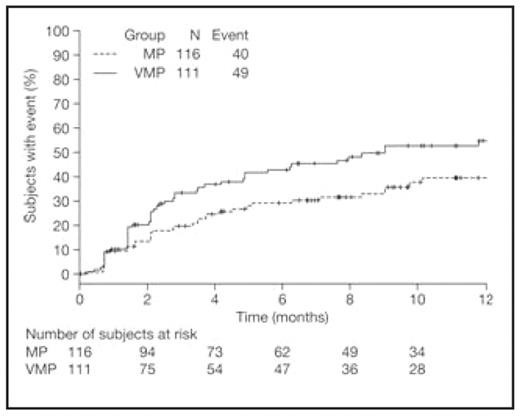Abstract
Renal impairment is a major complication of multiple myeloma (MM) and is associated with poor prognosis. Early effective treatment can lead to improvement in renal function, which is associated with better outcomes. Bortezomib (VELCADE®) is approved by the US FDA for the treatment of MM based on the results of the large, international, phase III VISTA study in previously untreated MM patients ineligible for high-dose therapy, in which bortezomib plus melphalan–prednisone (VMP, N=344) was superior to melphalan–prednisone (MP, N=338) across all efficacy end points, including response rates, time to progression (TTP), and overall survival (OS). Previous studies have shown bortezomib to be active and well tolerated in MM patients with renal impairment, including those requiring dialysis, and bortezomib pharmacokinetics are not influenced by degree of renal impairment (US label). In this analysis we assessed the efficacy and safety of VMP and MP in VISTA in patients with renal impairment. We also evaluated reversal of renal impairment after treatment. Treatment comprised nine 6-week cycles of VMP (bortezomib 1.3 mg/m2 on days 1, 4, 8, 11, 22, 25, 29, and 32, cycles 1–4, and days 1, 8, 22, and 29, cycles 5–9, plus melphalan 9 mg/m2 and prednisone 60 mg/m2 on days 1–4, cycles 1–9) or MP alone. Patients with serum creatinine >2 mg/dL were excluded. At baseline, 19 (6%), 162 (48%), and 159 (47%) VMP patients, and 15 (4%), 168 (50%), and 154 (46%) MP patients, had creatinine clearance (CrCl) ≤30, 31–60, and >60 mL/min, respectively. Efficacy of VMP was not affected by CrCl; complete response rate (28% vs 32%), TTP, and OS were not significantly different among patients with baseline CrCl ≤60 vs >60 mL/min. Safety profiles were comparable among patients with CrCl of 31–60 and >60 mL/min for both VMP and MP. In the VMP arm, rates of serious adverse events (SAEs; 42% vs 47%), grade 3 (52% vs 55%), 4 (28% vs 27%), and 5 (8% vs 8%) adverse events (AEs), and discontinuations due to AEs (13% vs 17%) were similar between the groups. Rates of SAEs (63%) and grade 4 AEs (42%) appeared somewhat higher in the small group of patients with CrCl ≤30 mL/min, but rate of discontinuations due to AEs (11%) was similar. Similar trends were seen in the MP arm, with rates of grade 4 and 5 AEs and discontinuations due to AEs appearing higher in patients with CrCl ≤30 mL/min, suggesting an effect independent of addition of bortezomib. Reversal of renal impairment, defined as an improvement in CrCl from <50 mL/min at baseline to >60 mL/min on treatment, was seen in 49/111 (44%) VMP patients vs 40/116 (34%) MP patients. Time to reversal in all patients with baseline CrCl <50 mL/min was significantly shorter with VMP (Figure; hazard ratio 1.586, p=0.03). Among patients achieving renal impairment reversal, median time to reversal was 2.1 months (range 0.2–11.8) with VMP and 2.4 months (range 0.2–13.6) with MP. By multivariate analysis, rate of reversal was significantly higher in younger patients (49% vs 30%, age <75 vs ≥75 years, p=0.006) and those with less severe renal impairment (42% vs 24%, CrCl ≥30 vs <30 mL/min, p=0.027), and showed a trend towards significance for VMP vs MP (odds ratio 1.50, p=0.07). Patients treated with VMP who achieved renal impairment reversal had a trend for longer OS (1-year rate: 90% vs 81%) and a better safety profile (lower rates of SAEs, grade 5 AEs, and discontinuations due to AEs) than those who did not. In conclusion, VMP represents a feasible, active, and well-tolerated treatment option for newly diagnosed MM patients with renal impairment, and results in reversal of renal impairment in a significant number of patients.
Kaplan-Meier analysis of time to reversal of renal impairment in patients with baseline CrCl <50 mL/min
Kaplan-Meier analysis of time to reversal of renal impairment in patients with baseline CrCl <50 mL/min
Disclosures: Dimopoulos:Ortho-Biotech: Honoraria. Richardson:Millenniun: Honoraria, Speakers Bureau; Celgene: Honoraria, Membership on an entity’s Board of Directors or advisory committees, Speakers Bureau; Johnson & Johnson: Honoraria, Speakers Bureau. Shpilberg:Johnson & Johnson: Membership on an entity’s Board of Directors or advisory committees. Kropff:Ortho-Biotech: Honoraria, Membership on an entity’s Board of Directors or advisory committees. Delforge:Janssen-Cilag: Consultancy, Membership on an entity’s Board of Directors or advisory committees. Alexeeva:Johnson & Johnson: Research Funding. Schots:Celgene: Consultancy, Honoraria; Pharmion: Consultancy. Mateos:Ortho-Biotech: Speakers Bureau; Janssen-Cilag: Speakers Bureau. Deraedt:Johnson & Johnson: Employment, Equity Ownership. Liu:Johnson & Johnson: Employment, Equity Ownership. Cakana:Johnson & Johnson: Employment. van de Velde:Johnson & Johnson: Employment, Equity Ownership. San Miguel:Ortho-Biotech: Membership on an entity’s Board of Directors or advisory committees; Millennium : Membership on an entity’s Board of Directors or advisory committees; Celgene: Membership on an entity’s Board of Directors or advisory committees; Pharmion: Membership on an entity’s Board of Directors or advisory committees.
Author notes
Corresponding author


